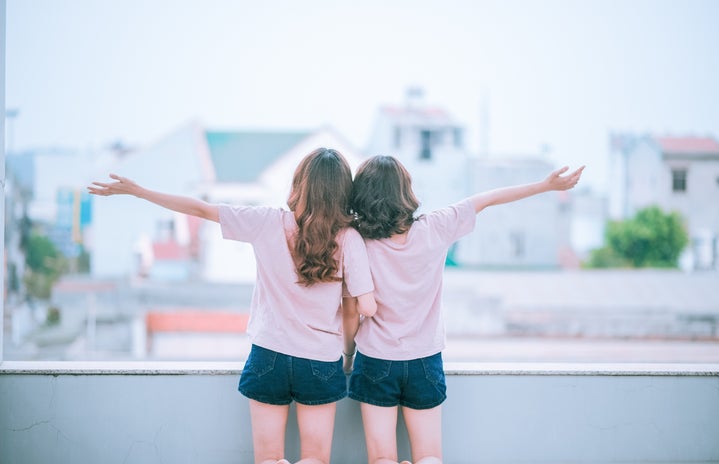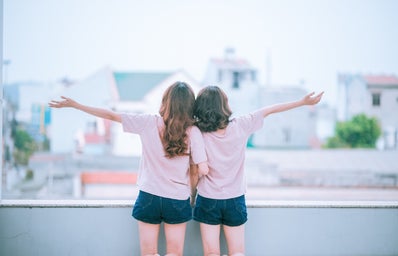H&M just released a stunning Autumn 2016 video campaign. Its models wear big gold earrings and bomber jackets, ruffled tops and cableknit sweaters, streetwear and underwear. But despite the styling, it’s not the clothes you notice first. It’s who’s wearing them.
We see a plus-size girl in the bathroom, admiring herself in the mirror. A group of friends wearing natural hairstyles and bonding over dinner. We watch one shot of a woman walking in to lead a business meeting while another runs her hands over her blonde buzz cut, smiling. Transgender model Hari Nef gazes into the distance from underneath an umbrella. Boxer Fatima Pinto gives her outfit quick glance before exiting an elevator. For the minute the video lasts, we so easily forget that this campaign was styled, directed, and produced. We forget that a camera crew had anything to do with it. We forget that we are watching models. These are shots of women living their lives. They sprawl their legs out from subway seats, sing karaoke, unzip their jeans before eating french fries, and roll their eyes at men. We close on a scene of two girls jumping into a pool and kissing in the illuminated water.
The women here are of all ages, races, body types, hair styles, and expressions. They are representative of the women we know in real life. They could be our friends, our sisters, and our role models. They could be us. The women here are not represented as perfect, especially by what many would call “society’s standards.” They have unshaved armpits and food stuck in their teeth. They aren’t “perfect,” but they’re not supposed to be. That’s what makes us love them so much and so quickly.
The ad plays against Lion Babe’s updated cover of Tom Jones’ “She’s a Lady.” It has lyrics like “she always knows her place” and “she’s never in the way” but in context, the song isn’t demeaning, it’s a reclamation. Especially when hearing these words sung by Jillian Hervey–who is also featured in the campaign–the “lady” isn’t the object of someone else’s desires anymore, but an entity of her own. These are women who belong to themselves only.
This isn’t the so-called “diversity” we are so used to seeing–where casting one black model amongst a sea of thin white girls somehow passes as representation in the eyes of so many brands, shows, and advertisers. For a long time, most of the diversity we have seen in media and fashion has only been through individuals carving out creative spaces for themselves. We’re not used to getting good representation from large corporations. This is only just beginning to change, and we can see that in H&M’s new campaign. This is good for all of us, and especially so for those who aren’t exposed–through social media or otherwise–to public figures who aren’t anything but white, cis, straight, and “pretty.” It’s important for people of all walks of life to be included in media because that is the reality of the world we live in.
It’s important however, that we remember what this is: an advertisement. It’s absolutely true that mega-corporations such as H&M pander to their consumer base. This reality leads us to beg questions like “Does that company really care about marriage equality or are they just capitalizing on the pride flag so we buy what they’re selling?” It’s a balancing act. So could it be that H&M is acting the part of “woke” to get our attention and cash? It’s tough to say, but maybe. However, brands don’t create trends. They follow them. The real pioneers are the “ladies” who live their lives authentic to themselves. The true trendsetters are the marginalized women and femmes who recognized that mainstream media didn’t greet them with open arms and in turn created their own platforms. If we take the example of this ad campaign, it’s probably safe to say that big brands are at least catching on to where we are. We can only hope that more will follow suit.
What is most important about H&M’s autumn campaign is that it shows that somebody is starting to realize that–shocker–women are diverse people. Even though media doesn’t always reflect it, there are more types of women than just the models we see in perfume ads between the pages of Vogue. Women of all types have always existed, and it’s important that the media realize and reflect that reality. Slowly but surely, things do seem to be changing for the better. We don’t always get to see women in media who have the luxury of existing outside of the male gaze. We don’t always see women acting on their own terms, and we don’t always see women who showcase more than one body type and color. It’s rare. But when we do get ads like H&M’s–little beacons of hope that say “Yes! We see you!–it’s so, so refreshing. And we need more of it.


